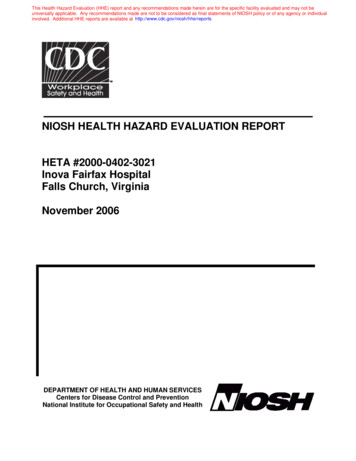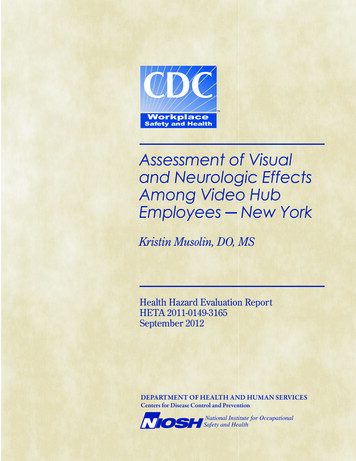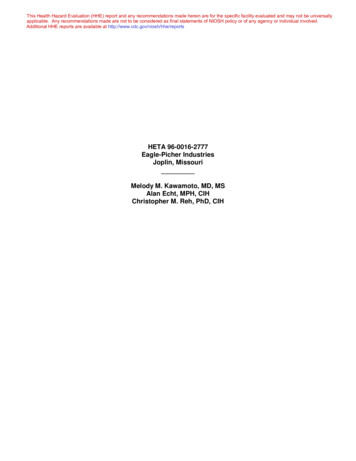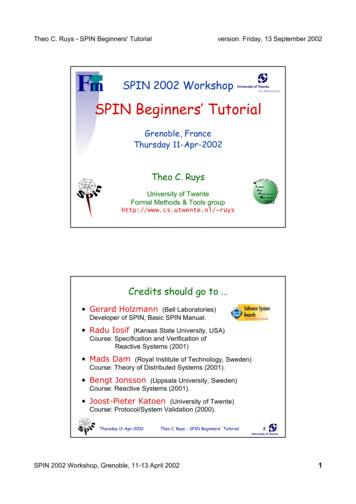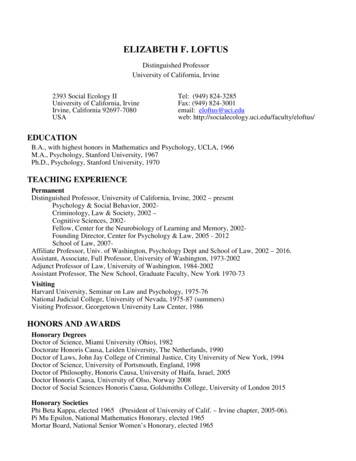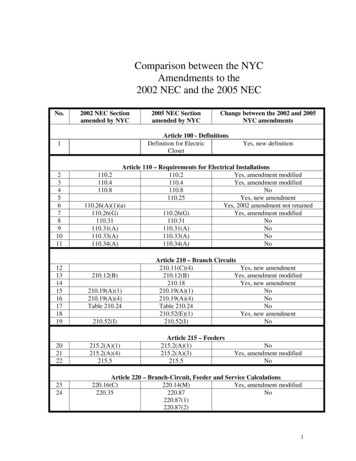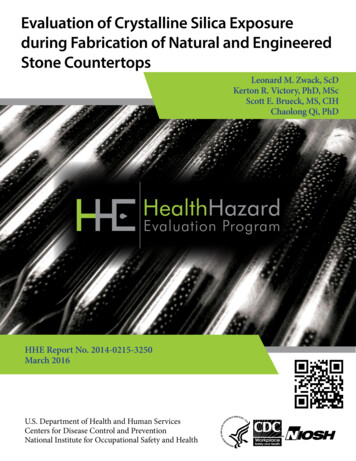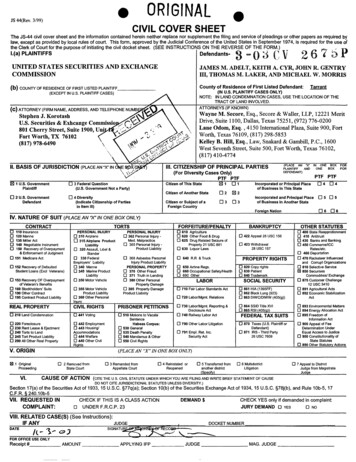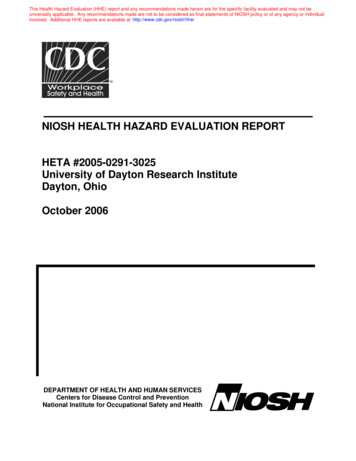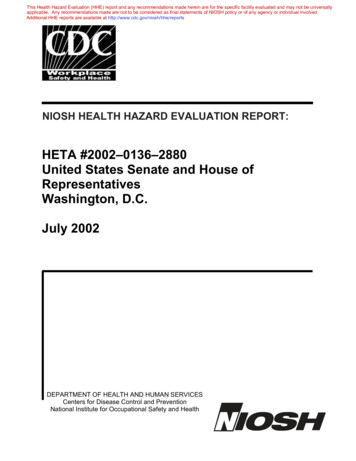
Transcription
ThisThis HealthHealth HazardHazard EvaluationEvaluation (HHE)(HHE) reportreport andand anyany recommendationsrecommendations mademade hereinherein areare forfor thethe specificspecific facilityfacility evaluatedevaluated andand maymay notnot bebe universallyuniversallyapplicable. /www.cdc.gov/niosh/hhe/reportsThis Health Hazard Evaluation (HHE) report and any recommendations made herein are for the specific facility evaluated and may not be universallyapplicable. Any recommendations made are not to be considered as final statements of NIOSH policy or of any agency or individual involved.Additional HHE reports are available at http://www.cdc.gov/niosh/hhe/reportsNIOSH HEALTH HAZARD EVALUATION REPORT:HETA #2002–0136–2880United States Senate and House ofRepresentativesWashington, D.C.July 2002DEPARTMENT OF HEALTH AND HUMAN SERVICESCenters for Disease Control and PreventionNational Institute for Occupational Safety and Health
PREFACEThe Hazard Evaluations and Technical Assistance Branch (HETAB) of the National Institute forOccupational Safety and Health (NIOSH) conducts field investigations of possible health hazards in theworkplace. These investigations are conducted under the authority of Section 20(a)(6) of the OccupationalSafety and Health (OSHA) Act of 1970, 29 U.S.C. 669(a)(6) which authorizes the Secretary of Health andHuman Services, following a written request from any employer or authorized representative of employees,to determine whether any substance normally found in the place of employment has potentially toxic effectsin such concentrations as used or found.HETAB also provides, upon request, technical and consultative assistance to Federal, State, and localagencies; labor; industry; and other groups or individuals to control occupational health hazards and toprevent related trauma and disease. Mention of company names or products does not constitute endorsementby NIOSH.ACKNOWLEDGMENTS AND AVAILABILITY OF REPORTThis report was prepared by Ronald Hall, Jeffery Hess, Bruce Bernard, Max Kiefer, Joshua Harney, DinoMattorano, Rob McCleery, Lisa Delaney, Matt Gillen, and Ken Mead of HETAB, Division of Surveillance,Hazard Evaluations and Field Studies (DSHEFS), Engineering and Physical Hazards Branch, Division ofApplied Research and Technology, and the Office of the Director, NIOSH. Industrial hygiene field assistancewas provided by David Sylvan, Mark Methner, and Erin Snyder. Medical field assistance was provided byMelody Kawamoto, Loren Tapp, and Debra Feldman. Analytical support was provided by Data ChemLaboratories and NIOSH Laboratories. Desktop publishing was performed by Pat McGraw, Robin Smith,and Ellen Blythe. Review and preparation for printing were performed by Penny Arthur.This report was reviewed by the United States Capital Police. For security reasons, the Capital Policeredacted certain portions of the report. The redacted portions of the report have been blacked out. Copiesof this report have been sent to the Sergeant at Arms of the United States Senate, and the Chief AdministrativeOfficer of the United States House of Representatives. This report is not copyrighted and may be freelyreproduced. Single copies of this report will be available for a period of three years from the date of thisreport. To expedite your request, include a self-addressed mailing label along with your written request to:NIOSH Publications Office4676 Columbia ParkwayCincinnati, Ohio 45226800-356-4674After this time, copies may be purchased from the National Technical Information Service (NTIS) at5825 Port Royal Road, Springfield, Virginia 22161. Information regarding the NTIS stock number may beobtained from the NIOSH Publications Office at the Cincinnati address.For the purpose of informing affected employees, copies of this report shall beposted by the employer in a prominent place accessible to the employees for a periodof 30 calendar days.ii
Highlights of the NIOSH Health Hazard EvaluationIrradiated Mail Handling and Opening at the CapitolOffice BuildingsThe National Institute for Occupational Safety and Health (NIOSH) is the federal agency responsible fordoing research in workplaces and making recommendations intended to prevent occupational illnessesand injuries. NIOSH is part of the Centers for Disease Control and Prevention. Researchers from theNIOSH health hazard evaluation program evaluate occupational health concerns of workers, workerrepresentatives, and employers. On February 8, 2002, NIOSH received a joint request from the Sergeantat Arms of the United States Senate and the Chief Administrative Officer of the United States House ofRepresentatives related to health concerns regarding handling and opening irradiated mail at the Capitoloffice buildings in Washington, D.C.were needed to the ventilation system. Theseadjustments have been made.What NIOSH Did##We measured the air for contaminants thatcould potentially come from irradiated mail.These were carbon monoxide, volatile organiccompounds, formaldehyde, ozone, particulate,polynuclear aromatic hydrocarbons, and toluenediisocyanate. Samples were collected in tenbuildings (Cannon, Capitol, Dirksen, Ford,Hart, House Post Office screening facility,Longworth, Rayburn, Russell, and the SenatePost Office screening facility) over three days.We chose sampling sites in each building usingsymptom reports and mail volume information.#We also measured carbon dioxide, temperature,and relative humidity. These indicators areused to assess indoor environmental quality.#We interviewed 389 employees in 120 officesregarding symptoms related to handling mail.#We met with and reviewed informationcollected by the Office of the AttendingPhysician (OAP). What NIOSH Found###Sampled substances were either not detected orwere found at low levels below those known tocause health problems. Low levels of manysubstances are typical in office buildings.The most commonly reported symptoms wereheadache, skin irritation, eye irritation, skinrash, dry hands, nausea, and nose or throatirritation. We believe it is likely that multiplefactors are responsible for the reportedsymptoms. These factors are described below:Because the irradiation process heats and driesout paper, handling of the treated mail can leadto dry skin and skin irritation in someemployees.Irradiated mail may produce odors, which someindividuals can smell at levels belowoccupational guidelines and in some casesbelow air monitoring detection limits. Theresponse to odor varies among individuals, andodors can potentially trigger symptoms such asheadaches, mucous membrane irritation, eyeirritation, and nausea in some individuals.Humidity levels in most buildings were notoptimal. Sub-optimal humidity levels can leadto eye and skin irritation.Heightened awareness and resultant employeestress from recent terrorist attacks may havecontributed to workers’ symptoms.We did not find evidence suggesting thepotential for long term health effects fromhandling irradiated mail.# We worked with the Legislative TaskForce, the OAP, and the GeneralServices Administration to developrecommendationsfor handlingirradiated mail in Capitol Hill officesSmall particulate counts indoors were generallymuch lower than outdoors. Exceptions werenoted in two small offices in the Hart SenateOffice Building which indicated adjustmentsiii
and offsite mail handling facilities.The recommendations aresummarized on the following page;full text is in the complete report.What Legislative Offices Can Do#What Employees Can Do####If you experience symptoms you feel areassociated with a specific work activity such ashandling irradiated mail, report them to theOAP. This will help the OAP understand whenand where problems are occurring.##Continue to wash hands with lotion-basedsoap, but liberally apply water-based handcream or lotion after each hand washing andthroughout the day to minimize drying yourskin.Encourage employees experiencing healthsymptoms to see their health care provider andreport symptoms to the OAP.Provide gloves made of breathable material toindividuals who choose to wear them.Encourage employees handling irradiated mailto liberally apply water-based hand cream orlotion after washing hands.Share all information about mail changes andmail handling procedures with employees.What Capitol Support Services Can Do#If you experience eye or nose dryness orirritation, use over-the-counter saline eye dropsor saline nose spray to help alleviatesymptoms. If symptoms do not improve, seeyour health care provider.## Handle mail in well ventilated areas.# Avoid touching mouth, eyes, or face when## If you choose to use gloves while##handling mail.handling irradiated mail, considerusing gloves made of breathablematerial. Change gloves when theyare grossly dirty or have perforationsin them, and remove gloves when eating,Track symptoms reported to the OAP toidentify patterns that suggest a work-relatedcause.If symptoms suggest a work-related cause inspecific areas, conduct an environmentalevaluation.Continue current efforts to maintain optimalhumidity levels.Provide mild lotion based soaps at employeewash stations.Provide timely communication of informationabout ongoing changes in mail and mailhandling procedures with legislative officesand employees.drinking, or smoking. Wash hands afterremoving gloves. Additional information ongloves is included in the full report.What To Do For More Information:We encourage you to read the full report. If youwould like a copy, contact the Office of theSenate Sergeant at Arms (4-2341) or the Officeof the Chief Administrative Officer for theHouse of Representatives (6-5155) or callNIOSH at 1-513-841-4252 and ask forHETA Report # 2002-0136-2880iv
Health Hazard Evaluation Report 2002–0136United Stated Senate and House of RepresentativesWashington, D.C.July 2002Ronald M. HallBruce BernardJoshua HarneyRob McCleeryMatt GillenJeffery E. HessMax KieferDino MattoranoLisa DelaneyKen MeadSUMMARYOn February 8, 2002, the National Institute for Occupational Safety and Health (NIOSH) received a joint requestfrom the Sergeant at Arms Office at the United States Senate and the Chief Administrative Officer at the UnitedStates House of Representatives regarding health concerns related to handling and opening irradiated mail at theUnited States Senate and House office buildings in Washington, D.C.In response to the request, NIOSH representatives conducted environmental and epidemiologic evaluations atthe Russell, Dirksen, Hart, Cannon, Longworth, Rayburn, and Ford Buildings, the Senate Post-Office ScreeningFacility, the House Mail Processing Facility, the Capitol building, and Postal Square on February 13-15, 2002. Theenvironmental evaluation included air sample collection for carbon dioxide, temperature, and relative humidity aswell as for contaminants potentially derived from heated mail as a result of irradiation, including small and totalparticulate, volatile organic compounds, formaldehyde, ozone, carbon monoxide, toluene diisocyanate, andpolynuclear aromatic hydrocarbons. In addition, bulk samples of irradiated mail and mail that had not gone throughthe irradiation process were analyzed for anions, metals, and pH. The epidemiologic evaluation consisted ofinterviews with individual employees who handled or had concerns about the mail, meetings with the SeniorMedical Officer from the Office of the Attending Physician (OAP), and review of data collected by the OAP.Air samples indicated non-detectable or low concentrations of sampled contaminants. The types and levels ofairborne substances we measured in areas where irradiated mail was handled were not distinguishable in ameaningful way from those measured in areas where irradiated mail was not handled. This comparison washindered in a few cases where employee interviews revealed that mail volumes and/or mail opening activities werelower on the day that samples were collected. We do not suspect that daily variability of the mail load will havean effect on the results of our environmental evaluation based on the number of buildings and offices evaluated,the number of samples collected, and the low concentrations of any detectable compounds. Many of the volatileorganic compounds that were detected are common in indoor air, and the results of the sampling for thesecompounds generally are similar to results seen by NIOSH in other indoor environments. The bulk sample analysisdid not provide information that could link irradiated mail to the reported health effects.Among the 389 Congressional staff employees interviewed, the most common symptoms were headache, skinirritation, eye irritation, skin rash, dry hands, nausea, and nose or throat irritation. We believe that it is likely thatmultiple factors are responsible for the reported symptoms. The added dryness of the mail from the irradiationprocess can lead to dryness and skin irritation from repeated handling of the mail. This is due to the absorptivev
effect of the damaged cellulose fibers from the irradiated paper drawing moisture off the skin. This drying effectcan cause the outer layer of the skin to dry out and fissure, causing chapped and irritated skin. Individuals with awe observed in ourhistory of atopy (allergies) may have been particularly vulnerable. Theenvironmental survey can also exacerbate the symptoms of eye and skin irritation that were seen.In general, established guidelines for occupational exposures are based on the goal of preventing and minimizingmeasurable adverse effects in healthy populations. They are not based on avoidance of odors, and many chemicalodors can be detected by smell at levels below exposure guidelines. Some odors can be detected by humans atlevels below those detectable using industrial hygiene techniques. There is evidence that irritation can be producedfrom volatile organic compounds at very low levels—levels which would trigger the activation and amplificationof the neurosensory mechanisms for an odor threshold (activating the sense of smell), but potentially below levelsthat we could measure for some compounds. Thus, odors could potentially trigger irritant symptoms experiencedby the employees, including some of the mucous membrane irritation and headaches.Adding to the unfamiliar and unpleasant odors causing headaches and irritation, skin irritation, and mucousmembrane irritation, was the fact that these occurrences happened in a climate of heightened awareness and unusualanxiety in these Government Buildings due to recent terrorist acts. It is possible that this heightened awareness andresultant employee stress, while not a root cause of the problem, may have contributed to problems caused by thehandling of the very dry irradiated mail.Environmental samples collected across several Capitol Hill building locations over a three day period did notreveal any exposures exceeding any existing occupational guidelines. In addition, exposures in irradiated maillocations were not demonstrably higher than exposures in control locations where no mail was opened. Thesefindings are similar to what has been found in other recent investigations of irradiated mail. Medical interviewsdid result in finding a fairly high number of individuals reporting symptoms of irritation. As noted above, theabsorptive effect of the irradiated paper drawing moisture off the skin could account for some of the symptoms,other irritant symptoms may be due to odors associated with the mail, still others due to theand heightened awareness. Therefore, it is likely that a number of causes were responsible forthe reported symptoms. Recommendations are provided in the report.Keywords: SIC 9121 Legislative Bodies. Irradiated Mail, Indoor air quality, Indoor environmental quality,headache, skin irritation, eye irritation, skin rash, dry hands, nausea, and nose or throat irritation.vi
TABLE OF CONTENTS. 1Preface . . . . . . . . . . . . . . . . . . . . . . . . . . . . . . . . . . . . . . . . . . . . . . . . . . . . . . . . . . . . . . . . . . . . . . . . . . . . iiAcknowledgments and Availability of Report . . . . . . . . . . . . . . . . . . . . . . . . . . . . . . . . . . . . . . . . . . . . . . . . iiSummary . . . . . . . . . . . . . . . . . . . . . . . . . . . . . . . . . . . . . . . . . . . . . . . . . . . . . . . . . . . . . . . . . . . . . . . . . . . vIntroduction . . . . . . . . . . . . . . . . . . . . . . . . . . . . . . . . . . . . . . . . . . . . . . . . . . . . . . . . . . . . . . . . . . . . . . . . . 1Methods . . . . . . . . . . . . . . . . . . . . . . . . . . . . . . . . . . . . . . . . . . . . . . . . . . . . . . . . . . . . . . . . . . . . . . . . . . .Industrial Hygiene Methods . . . . . . . . . . . . . . . . . . . . . . . . . . . . . . . . . . . . . . . . . . . . . . . . . . . . . . . . .Volatile Organic Compounds (VOCs) . . . . . . . . . . . . . . . . . . . . . . . . . . . . . . . . . . . . . . . . . . . . . . . . . .Thermal Desorption Tubes . . . . . . . . . . . . . . . . . . . . . . . . . . . . . . . . . . . . . . . . . . . . . . . . . . . . . . .Charcoal Tubes . . . . . . . . . . . . . . . . . . . . . . . . . . . . . . . . . . . . . . . . . . . . . . . . . . . . . . . . . . . . . . . .Direct Reading . . . . . . . . . . . . . . . . . . . . . . . . . . . . . . . . . . . . . . . . . . . . . . . . . . . . . . . . . . . . . . . .Formaldehyde . . . . . . . . . . . . . . . . . . . . . . . . . . . . . . . . . . . . . . . . . . . . . . . . . . . . . . . . . . . . . . . . . . . .Ozone . . . . . . . . . . . . . . . . . . . . . . . . . . . . . . . . . . . . . . . . . . . . . . . . . . . . . . . . . . . . . . . . . . . . . . . . . .Carbon Monoxide . . . . . . . . . . . . . . . . . . . . . . . . . . . . . . . . . . . . . . . . . . . . . . . . . . . . . . . . . . . . . . . . .Toluene Diisocyanate . . . . . . . . . . . . . . . . . . . . . . . . . . . . . . . . . . . . . . . . . . . . . . . . . . . . . . . . . . . . . .Polynuclear Aromatic Hydrocarbons . . . . . . . . . . . . . . . . . . . . . . . . . . . . . . . . . . . . . . . . . . . . . . . . . . .Direct Reading–Temperature, RH, CO, and CO2 . . . . . . . . . . . . . . . . . . . . . . . . . . . . . . . . . . . . . . . . . .Total Particulate and Particle Size Analysis . . . . . . . . . . . . . . . . . . . . . . . . . . . . . . . . . . . . . . . . . . . . . .Small Particulate . . . . . . . . . . . . . . . . . . . . . . . . . . . . . . . . . . . . . . . . . . . . . . . . . . . . . . . . . . . . . . . . . .Bulk Samples . . . . . . . . . . . . . . . . . . . . . . . . . . . . . . . . . . . . . . . . . . . . . . . . . . . . . . . . . . . . . . . . . . . .111122222233344Medical Methods . . . . . . . . . . . . . . . . . . . . . . . . . . . . . . . . . . . . . . . . . . . . . . . . . . . . . . . . . . . . . . . . . . . . . 4Evaluation Criteria . . . . . . . . . . . . . . . . . . . . . . . . . . . . . . . . . . . . . . . . . . . . . . . . . . . . . . . . . . . . . . . . . . . .Indoor Environmental Quality (IEQ) . . . . . . . . . . . . . . . . . . . . . . . . . . . . . . . . . . . . . . . . . . . . . . . . . . .Temperature and RH . . . . . . . . . . . . . . . . . . . . . . . . . . . . . . . . . . . . . . . . . . . . . . . . . . . . . . . . . . . . . . .Carbon Monoxide (CO) . . . . . . . . . . . . . . . . . . . . . . . . . . . . . . . . . . . . . . . . . . . . . . . . . . . . . . . . . . . .Carbon Dioxide (CO2) . . . . . . . . . . . . . . . . . . . . . . . . . . . . . . . . . . . . . . . . . . . . . . . . . . . . . . . . . . . . . .Volatile Organic Compounds (VOCs) . . . . . . . . . . . . . . . . . . . . . . . . . . . . . . . . . . . . . . . . . . . . . . . . . .Formaldehyde . . . . . . . . . . . . . . . . . . . . . . . . . . . . . . . . . . . . . . . . . . . . . . . . . . . . . . . . . . . . . . . . . . . .4566777Information Concerning Paper . . . . . . . . . . . . . . . . . . . . . . . . . . . . . . . . . . . . . . . . . . . . . . . . . . . . . . . . . . . 8Industrial Hygiene Results, Discussion, and Conclusions for Each Building . . . . . . . . . . . . . . . . . . . . . . . . . 9February 13, 2002 . . . . . . . . . . . . . . . . . . . . . . . . . . . . . . . . . . . . . . . . . . . . . . . . . . . . . . . . . . . . . . . . . 9Russell Building . . . . . . . . . . . . . . . . . . . . . . . . . . . . . . . . . . . . . . . . . . . . . . . . . . . . . . . . . . . . . . . 9Cannon Building . . . . . . . . . . . . . . . . . . . . . . . . . . . . . . . . . . . . . . . . . . . . . . . . . . . . . . . . . . . . . 10Longworth Building . . . . . . . . . . . . . . . . . . . . . . . . . . . . . . . . . . . . . . . . . . . . . . . . . . . . . . . . . . . 11Senate Post-Office Screening Facility . . . . . . . . . . . . . . . . . . . . . . . . . . . . . . . . . . . . . . . . . . . . . . 11February 14, 2002 . . . . . . . . . . . . . . . . . . . . . . . . . . . . . . . . . . . . . . . . . . . . . . . . . . . . . . . . . . . . . . . . 13Hart Office Building . . . . . . . . . . . . . . . . . . . . . . . . . . . . . . . . . . . . . . . . . . . . . . . . . . . . . . . . . . . 13Dirksen Office Building . . . . . . . . . . . . . . . . . . . . . . . . . . . . . . . . . . . . . . . . . . . . . . . . . . . . . . . . 14Rayburn Building . . . . . . . . . . . . . . . . . . . . . . . . . . . . . . . . . . . . . . . . . . . . . . . . . . . . . . . . . . . . . 15House Post-Office Screening Facility . . . . . . . . . . . . . . . . . . . . . . . . . . . . . . . . . . . . . . . . . . . . . . 16February 15, 2002 . . . . . . . . . . . . . . . . . . . . . . . . . . . . . . . . . . . . . . . . . . . . . . . . . . . . . . . . . . . . . . . . 17
Russell Building . . . . . . . . . . . . . . . . . . . . . . . . . . . . . . . . . . . . . . . . . . . . . . . . . . . . . . . . . . . . . .Dirksen and Hart Buildings . . . . . . . . . . . . . . . . . . . . . . . . . . . . . . . . . . . . . . . . . . . . . . . . . . . . . .Capitol Building . . . . . . . . . . . . . . . . . . . . . . . . . . . . . . . . . . . . . . . . . . . . . . . . . . . . . . . . . . . . . .Ford Building . . . . . . . . . . . . . . . . . . . . . . . . . . . . . . . . . . . . . . . . . . . . . . . . . . . . . . . . . . . . . . . .17181919Bulk Sample Results . . . . . . . . . . . . . . . . . . . . . . . . . . . . . . . . . . . . . . . . . . . . . . . . . . . . . . . . . . . . . . . . .Anion . . . . . . . . . . . . . . . . . . . . . . . . . . . . . . . . . . . . . . . . . . . . . . . . . . . . . . . . . . . . . . . . . . . . . . . . .Metals and pH . . . . . . . . . . . . . . . . . . . . . . . . . . . . . . . . . . . . . . . . . . . . . . . . . . . . . . . . . . . . . . . . . .Screening via Electrospray-Mass Spectrometry . . . . . . . . . . . . . . . . . . . . . . . . . . . . . . . . . . . . . . . . . .20202021Total Particulate and Particle Size Analysis Results . . . . . . . . . . . . . . . . . . . . . . . . . . . . . . . . . . . . . . . . . . 21Small Particulate Results . . . . . . . . . . . . . . . . . . . . . . . . . . . . . . . . . . . . . . . . . . . . . . . . . . . . . . . . . . . . . . 21Medical Results . . . . . . . . . . . . . . . . . . . . . . . . . . . . . . . . . . . . . . . . . . . . . . . . . . . . . . . . . . . . . . . . . . . . . 22Medical Interviews with Employees . . . . . . . . . . . . . . . . . . . . . . . . . . . . . . . . . . . . . . . . . . . . . . . . . . 22Medical Data from the Office of the Attending Physician . . . . . . . . . . . . . . . . . . . . . . . . . . . . . . . . . . 22Medical Discussion . . . . . . . . . . . . . . . . . . . . . . . . . . . . . . . . . . . . . . . . . . . . . . . . . . . . . . . . . . . . . . . . . . 23Conclusions . . . . . . . . . . . . . . . . . . . . . . . . . . . . . . . . . . . . . . . . . . . . . . . . . . . . . . . . . . . . . . . . . . . . . . . . 24Recommendations . . . . . . . . . . . . . . . . . . . . . . . . . . . . . . . . . . . . . . . . . . . . . . . . . . . . . . . . . . . . . . . . . . . 25References . . . . . . . . . . . . . . . . . . . . . . . . . . . . . . . . . . . . . . . . . . . . . . . . . . . . . . . . . . . . . . . . . . . . . . . . . 26Data Tables . . . . . . . . . . . . . . . . . . . . . . . . . . . . . . . . . . . . . . . . . . . . . . . . . . . . . . . . . . . . . . . . . . . . . . . . 31Appendix A . . . . . . . . . . . . . . . . . . . . . . . . . . . . . . . . . . . . . . . . . . . . . . . . . . . . . . . . . . . . . . . . . . . . . . . . 60Appendix B . . . . . . . . . . . . . . . . . . . . . . . . . . . . . . . . . . . . . . . . . . . . . . . . . . . . . . . . . . . . . . . . . . . . . . . . 70viii
INTRODUCTIONOn February 7, 2002, the National Institute forOccupational Safety and Health (NIOSH) received ajoint request for a Health Hazard Evaluation (HHE)from the Sergeant at Arms of the United StatesSenate and the Chief Administrative Officer of theHouse of Representatives regarding health concernsrelated to handling and opening irradiated mail at theUnited States Senate and House of Representativesoffice buildings in Washington, D.C. Employeesexpressed concerns about symptoms such as nosebleeds, eye irritation, and headaches. From February13-15, 2002, NIOSH representatives conductedenvironmental and epidemiologic evaluations atmultiple Federal Office Buildings. This reportpresents the results of our evaluations, includingconclusions and recommendations.METHODSOn February 8, a preliminary strategy describingNIOSH plans for selecting sampling locations,selecting contaminants for evaluation, and collectingmedical information on symptoms was presented tothe U.S. Capitol Legislative Mail Task Force forcomment and discussion. Agreement on the generalapproach was provided by members of the TaskForce, including representatives of the U.S.Environmental Protection Agency (EPA), the U.S.Postal Service, the Defense Advanced ResearchProjects Agency (DARPA), the Armed ForcesRadiobiology Research Institute (AFRRI), theLawrence Livermore National Laboratory, and theWhite House Office of Science and TechnologyPolicy. Agreement was also reached to encouragecollaboration on sampling, with AFRRI agreeing toperform concurrent sampling over the three days ofthe HHE. AFRRI’s independent report is attached asAppendix B.Industrial Hygiene MethodsThe environmental and epidemiological evaluationswere conducted on February 13-15, 2002. OnFebruary 13, environmental sampling was conductedHealth Hazard Evaluation Report No. 2002–0136in the Russell, Cannon, and Longworth buildings,and in the Senate Post-Office Screening Facility. OnFebruary 14, environmental sampling was conductedin the Hart, Dirksen, and Rayburn buildings, and inthe House Post-Office Screening Facility. OnFebruary 15, sampling was conducted in the Russell,Hart, Dirksen, Capitol, and Ford buildings.Senators’ and Representatives’ offices were chosenfor evaluation based either on health complaintsattributed to mail handling, or because the officehandles a relatively high volume of mail. Airsamples were collected in areas where workershandled and opened irradiated mail. Samples werealso collected where no irradiated mail was stored orhandled and outdoors for comparison.We sampled for contaminants that may be derivedfrom heated mail as a result of irradiation and thatcould be associated with worker symptoms includingsmall particulate, volatile organic compounds(VOCs), formaldehyde, ozone, carbon monoxide,toluene diisocyanate (TDI), polynuclear aromatichydrocarbons (PAHs), and total particulate. We alsomeasured typical indoor air environmentalparameters such as carbon dioxide (CO2),temperature, and relative humidity (RH).Volatile Organic Compounds(VOCs)Thermal Desorption TubesArea air samples were collected on thermaldesorption tubes to identify VOCs. The thermaldesorption tubes were attached by Tygon tubing tosampling pumps calibrated at a flow rate of 50 cubiccentimeters per minute (cc/min). Each thermaldesorption tube contained three beds of sorbentmaterial: a front layer of Carbopack Y , a middlelayer of Carbopack B , and a back section ofCarboxen 1003 . The thermal desorption tubeswere analyzed by the NIOSH laboratory usingstainless steel tubes configured for thermaldesorption in a Perkin–Elmer ATD 400 automaticthermal desorption system and analyzed using a gaschromatograph with a mass selective detector. Thetypical desorption procedure for thermal desorptionPage 1
tubes is suited for most common organic solventswith a molecular weight below 300 and boilingpoints around 200 C or less. The thermaldesorption tubes collected during this evaluationwere desorbed in the ATD at 300 C for 10 minutes.Samples were analyzed according to NIOSHanalytical method 2549.1 Some of the compoundsidentified on thermal desorption tubes were selectedfor further scrutiny via charcoal tube analysis, abetter ‘quantitative’ method than thermal desorptiontube analysis. They were selected because of theirgreater relative abundance, compared to othercompounds detected on the thermal desorption tubes,or because of their known irritating or toxicproperties.Charcoal TubesThe charcoal tubes were attached by Tygon tubingto sampling pumps calibrated at a flow rate of 200cc/min. The charcoal tubes were sent to DatachemLaboratories, Inc. (Salt Lake City, UT) to bequantitatively analyzed for compounds of interest(identified on the thermal tubes) using aHewlett-Packard model 5890A gas chromatographequipped with a flame ionization detector.Direct ReadingA Mini
Review and preparation for printing were performed by Penny Arthur. This report was reviewed by the United States Capital Police. . Virginia 22161. Information regarding the NTIS stock number may be obtained from the NIOSH Publications Office at the Cincinnati address. For the purpose of informing affected employees, copies of this report .

